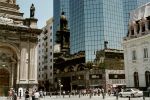 |
The Santiago cathedral reflected in the
mirrored windows of a skyscraper
I started in Santiago, where I stayed one night. I spent the afternoon walking, went to the Plaza de Armas, along the pedestrian malls, over to the river, to the markets across the river, and ate a dinner of Chinese food (who knows, I just felt like it). Early in the AM I packed, and headed out to the subway, which has a stop under the bus terminal. As quickly as I could buy a ticket I was on a bus to Valparaiso. |
||
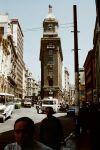 |
Turri clock tower, Valparaiso
I was in Valparaiso early enough to spend most of the day on the streets. I found a place to stay near the bus station and the incredibly ugly National Congress Building. Then I walked to the far end of the heart of town, getting a feel for the city. It occupies a narrow coastal plain (3 to 4 blocks) at the base of steep hills and cliffs. Each hill is isolated by a gully on each side, and each has its own character and identity. It's said there are 45 of the cerros (hills). |
||
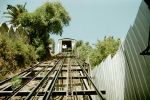 |
Looking up the Turri
or Cerro Concepción ascensor, Valparaiso
Many of the cerros have ascensores - literally elevators but here usually funicular railways (one, Ascensor Polanco, is an actual elevator). These are as old as the 1880s in some cases, and have two counterbalanced cars that go up and down continuously, with a round trip usually costing about 200 pesos (less than 40 cents US). |
||
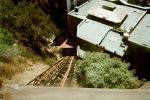 |
Looking down
the Cerro Concepción ascensor, Valparaiso
I began seeking out and riding the ascensores, eventually going up and down about 8 of them. Each neighborhood was different; some rich, some poor; some almost all residential, some with many businesses. |
||
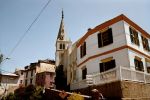 |
In Cerro Concepción
neighborhood, Valparaiso
Cerro Concepción neighborhood is mostly quite well to do, with some hotels, the art museum, and what was once the English community. Here is a Lutheran Church. It looked like a great area to live! |
||
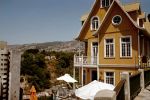 |
A bed and breakfast, near the Cerro
Concepción ascensor, Valparaiso
The heart of downtown Valparaiso is immediately below the area around the Cerro Concepción ascensor, with great views, both long distance and straight down. |
||
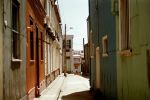 |
A quiet street, in Cerro
Concepción neighborhood, Valparaiso
The kind of neighborhood I'd choose if I lived in Valparaiso! |
||
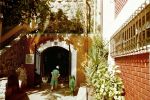 |
Entrance to Ascensor Polanco, Valparaiso
Ascensor Polanco was the first one to be made a World Heritage site; all are now. It is different from the rest - it has a tunnel into the hill, then you go up an elevator. Part of the way up the hill it comes out of the ground (and has a stop) and then it continues up to the top of a tower. From the top there's a bridge to the upper part of the neighborhood. |
||
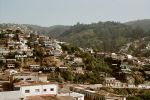 |
View from top of
Ascensor Polanco, Valparaiso
The views are stunning from the top of Ascensor Polanco, and the colorful, decaying neighborhood is quite photogenic. Many of the homes looked unlivable from the outside, but the occasional glimpse through a window showed that in fact they were sometimes quite nice inside, with the outside in a state of "arrested decay." Almost all are made of sheet metal and many bright hues are represented in the color schemes. |
||
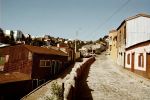 |
Neighborhood above
Ascensor Polanco, Valparaiso
Narrow streets wind from the top of the of Ascensor Polanco, climbing high into the hills above. |
||
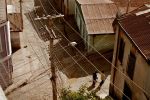 |
Looking down on hill
neighborhood, Ascensor Polanco, Valparaiso
This is an area near the intermediate stop. |
||
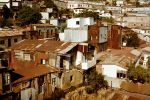 |
Hill neighborhood,
Ascensor Polanco area, Valparaiso
Yes, these homes are livable! |
||
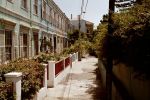 |
Homes off a courtyard, Cerro
Concepción neighborhood, Valparaiso
The next morning I went back downtown (rode a bus this time, tired feet) and after spending some time on the waterfront went up another of ascensor (Ascensor El Perral) and wandered the hills above, descending by the Cerro Concepción (Turri) ascensor. Then I packed and bought tickets to La Serena, accomplished by a van through Viña del Mar to the Panamericano north of Santiago, where I caught the bus. |
||
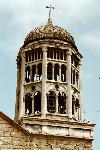 |
Bell tower, colonial church, La Serena
I arrived in La Serena late and spent a day and two nights there. It's the best-preserved colonial town in Chile. I liked the colonial town and enjoyed the Plaza de Armas, museums, and the fine beaches. |
||
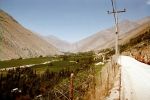 |
Oasis-like Elqui
Valley, near Pisco Elqui
On my second morning in La Serena, I took a bus as far as they go up the valley to the village of Pisco Elqui, a farming town well into the mountains. |
||
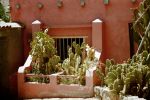 |
Adobe and cactus garden, Pisco
Elqui
Pisco Elqui clings to steep slopes above a branch of the Elqui river. Though the main crop here is the muscat grapes used to make most of Chile's finest Pisco (a South American brandy), the Elqui Valley is also Chile's prime tropical fruit growing region, with chirimoya, papaya, figs, etc. growing in profusion in the irrigated valley. Later in the day, I went back down the valley to the larger town of Vicuña, where I stayed in a residencial that had an idyllic yard in back - surrounded by high adobe walls, it had a small irrigation ditch running through, and was filled with tropical and subtropical fruit trees, flowers, and vegetables. It felt like something out of Arabian Nights. |
||
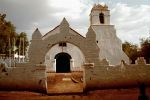 |
Church and arch, San
Pedro de la Atacama
In the morning I took a bus back to La Serena, then on to Copaipo for the night (not a very exciting place, though they have an excellent mineralogical museum you should see if you are in the area), and the next day on to Calama where I quickly caught a bus on to San Pedro de la Atacama, a remote village in the highest part of the Atacama desert that is popular with Chilean and gringo tourists. The oasis village, possibly Chile's oldest town, has no paved or cobbled streets and all the buildings are of adobe. There are lots of inexpensive and pleasant places to stay and many decent eateries, too. Tour operators offer full or half-day tours to local attractions such as the Tatio geysers and the Valle de la Luna, or longer tours by 4-wheel-drive caravan to international destinations such as the Bolivian salar country. |
||
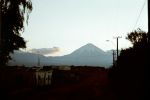 |
Dawn over Volcan
Licancabur, San Pedro de la Atacama
Several volcanoes, as high as 6150 meters (20,000+ feet), provide the eastern skyline of San Pedro. Here pre-dawn light silhouettes Licancabur, 5916 meters (19,400 feet). |
||
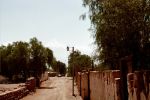 |
Street scene, San
Pedro de la Atacama
Always quiet! |
||
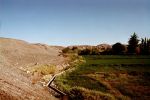 |
Margin between the
oasis and the desert, San Pedro de la Atacama
The oasis ends abruptly, and even at over 2400 meters the desert is free from vegetation except in oases or a few valleys with salt-tolerant vegetation. It is mostly as barren as a gravel pit. I'm told that when enough rain falls, flowers sprout from decades-dormant seeds; but the rare showers I experienced (two days in a row) barely lasted long enough to wet the ground. |
||
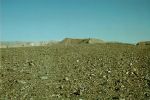 |
Desert scene near San Pedro de la
Atacama
Not even a blade of grass in sight, a typical sight in the Atacama. |
||
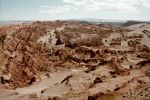 |
Stark hills, Valle de Muerte, near San Pedro de la Atacama
As the easiest way to get into the areas outside of town, I took an all-afternoon tour. We went up to the Valle de Muerte, into the solid salt hills of the Valle de la Luna, and saw the sunset from a huge dune. |
||
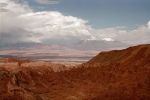 |
Thunderstorms break
out over the volcanoes, near San Pedro de la Atacama
Most of the rain fell in the mountains, though we had a few drips. |
||
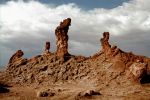 |
Salt towers in the
Valle de la Luna, near San Pedro de la Atacama
The whole range of hills is made of salt, with the surface covered by a veneer of sand that blows in and stays behind as the salt is melted in rare rains. Occasionally there are odd formations... |
||
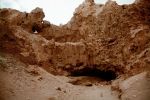 |
Salt canyon near San
Pedro de la Atacama - the cave in the middle is the route of the trail
Here a canyon cuts into the salt bedrock. As the day cooled, the salt shrank noisily. |
||
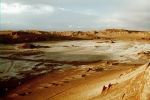 |
Salt flats resembling
snow, Valle de la Luna, near San Pedro de la Atacama
After a rain, salt in the flat areas crystallizes on the surface. |
||
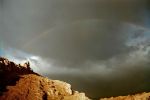 |
Rainbow over the
Valle de la Luna, near San Pedro de la Atacama
We went to a big dune (with a few rock peaks at the top) in Valle de la Luna for the sunset, and as it grew near, saw this rainbow in the east, over the Andes. |
||
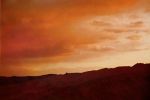 |
Sunset over the Valle
de la Luna, near San Pedro de la Atacama
I shot about 15 pictures - when will I learn? |
||
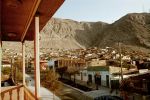 |
Sleepy Atacama desert
seaport of Tocopilla, from my hotel balcony
The next day I took a bus to Calama and a collectivo (shared taxi) to the coast, arriving late in the day in a sleepy port called Tocopilla. I found the only obvious hotel - one of the nicest I had, oddly enough, with the treat of my only cable TV on the entire trip! This shot shows a typical Atacama coastal town; the dense urban area ends absolutely abruptly at the edge of the steep mountains. Near the coast an occasional plant grows at the base of canyons where a tiny amount of water is available from the daily coastal fogs. |
||
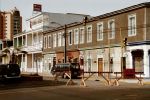 |
Nineteenth century
street, Iquique
I made it to the old mining port of Iquique - now a glittering resort with a large zona franca (duty free area). Many of the old buildings are quite nice, and there is a good regional museum. Over the south part of town, swallowing some neighborhoods, is what locals call the world's largest dune, about 200 meters high. |
||
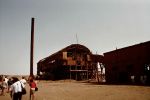 |
Abandoned
ore-crushing mill, Santa Laura ghost town, near Iquique, Atacama
desert
Like San Pedro, Iquique's a good area to take day tours from, so I signed up for one the next day to see the ghost towns, oasis towns, and giant geoglyphs east of Iquique. The tour first stopped at two ghost towns, Santa Laura and the more town-like Santiago Humberstone (pronounced OOM-ber-stone). |
||
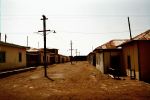 |
Empty street,
Santiago Humberstone ghost town, near Iquique, Atacama desert
We wandered Humberstone for about half an hour - it's almost in good enough shape to move right in. There's small homes, mansions, a large theater, city hall, stables, streets, power poles... |
||
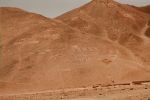 |
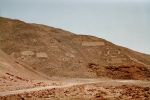
|
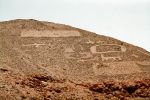
|
Giant geoglyphs at Pintados, near Iquique, Atacama desert
Further on was my high point of the day, giant geoglyphs at Pintados. Over 400 paintings on the earth's surface decorate the hills over an area presumed to be an ancient trading place.
|
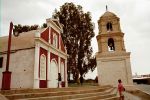 |
Church at Matilla,
near Iquique, Atacama desert
The only colonial church in the country with a bell tower that isn't attached, I'm told. The area is an extensive oasis (Oasis de Pica) watered by long tunnels - effectively the same as Arab qanats, and said to be the only qanats in the western hemisphere - that go for many miles into the alluvial fans at the base of the high mountains. |
||
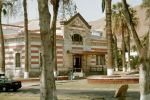 |
Old customs house,
Arica, almost on the Peruvian border, Atacama desert
I stayed one night in the city of Arica, a nice enough city with an impressive monolithic mountain south of downtown a few dozen meters. A stretch of 6 or 8 blocks of pedestrian mall reminds one of Santiago, and makes downtown quite pleasant. Peru is only a couple of kilometers away, and Bolivia about 150 kilometers inland. Goodbye to Chile - follow me on to Bolivia and Peru! |
||